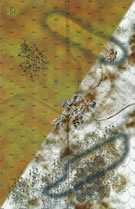|
Quantity vs. Quality Hammer & Sickle #19 |
||
|---|---|---|
| (Attacker) Soviet Union | vs | United States (Attacker) |
| Formations Involved | ||
|---|---|---|
| Soviet Union |  |
50th Guards Armor Regiment |

|
| Overall Rating, 4 votes |
|---|
|
3
|
| Scenario Rank: --- of 964 |
| Parent Game | Hammer & Sickle |
|---|---|
| Historicity | Alt-History |
| Date | 1951-11-01 |
| Start Time | 07:00 |
| Turn Count | 12 |
| Visibility | Day |
| Counters | 12 |
| Net Morale | 0 |
| Net Initiative | 1 |
| Maps | 1: 24 |
| Layout Dimensions | 43 x 28 cm 17 x 11 in |
| Play Bounty | 133 |
| AAR Bounty | 161 |
| Total Plays | 4 |
| Total AARs | 2 |
| Battle Types |
|---|
| Inflict Enemy Casualties |
| Meeting Engagement |
| Road Control |
| Scenario Requirements & Playability | |
|---|---|
| Elsenborn Ridge | Maps + Counters |
| Hammer & Sickle | Base Game |
| Road to Berlin | Counters |
| Introduction |
|---|
|
Quality versus quantity was a huge discussion point during the Cold War. Usually, it was the Western nations with the qualitative edge, and the Warsaw Pact with the quantity. However, in this battle the Soviet JS3s and JS4s are markedly superior to the American World War II-era tanks. They mount superior guns as well as thicker armor. And though they generally can't match the crew performance or speed of the American tanks, the armor and weaponry still play a decisive role. In this last gasp by the American V Corps, a battalion of their tanks charges into a company of Soviets. |
| Conclusion |
|---|
|
This meeting engagement provides a challenge to both sides. With better armor and anti-tank fire, the Soviet tanks have the edge. But a lucky roll is a lucky roll, and can ruin his day, especially if the Americans set up some crossfires. So the skillful use of terrain will come into play as both sides play hide and seek. |
| Additional Notes |
|---|
|
G2 note: Book says 11th Tank Corps/Division in Oct 1945. |
| AFV Rules Pertaining to this Scenario's Order of Battle |
|---|
|
| 1 Errata Item | |
|---|---|

|
The M18 has a special rule in Battle of the Bulge but it applies globally: "A two-step M18 unit can fire one anti-tank shot and move half its movement allowance (retain fractions) in a single impulse. The order in which it does these two actions is the player's choice." (Shad
on 2010 Dec 15)
|
| Hammer & Sickle, scenario #19: Quantity vs. Quality | ||||||||||||
|---|---|---|---|---|---|---|---|---|---|---|---|---|
Ok this is a very small armor vs. armor scenario with Soviet JS4s vs. American M4/76s & M18s. It started badly for the Americans as the Soviets won the first activation having a higher initiative to begin with, so they moved the three platoons of JS4s into town covering the Americans entry on the south edge of the map but also increasing their defensive armor value from 8 to 9 by being in town hexes. The only thing the American weak M4s and M18s armor could do was try for crossfire bonus shots, adjacent shots and assault combat. The American armor was turned into scrap metal, all 9 platoons of it, the best they could do against the heavy Soviet beast was a disruption in assault combat. If they could have rolled better dice in those assaults they may have been able to eliminate a few steps but today the dice didn’t help them at all. This was a clear hands-down, Major Soviet Victory! I could have used the help of a few Pershing tanks in this one! |
||||||||||||
| 0 Comments |
| But quality needs SOME quantity | ||||||||||||
|---|---|---|---|---|---|---|---|---|---|---|---|---|
The problem for the Soviets in this one is that with only three units they will almost certainly be in crossfire. With efficiency even the +1 rolls will result in terrible losses. It would seem that the best strategy for the Americans is to split up and use the M18s to start the crossfire with their single shot then move, leaving the M4/76s to fire at will thereafter. Through movement the Americans can keep the Stalins off balance and needing to move to defend the road. There simply aren't enough Soviet tanks to maintain positions and fire. Add to that the woeful rolls that I had for my Soviets (a +5 really should work most of the time...) and you have a recipe for disaster for the H&S men. This is a very quick playing scenario, as in all tank only battles in PG, with maneuver for crossfire and the following crossed fingers absorbing most of the time. It was fun and quick but nothing really out of the ordinary. I give it a "3". |
||||||||||||
| 0 Comments |

 HaSi018
HaSi018 





